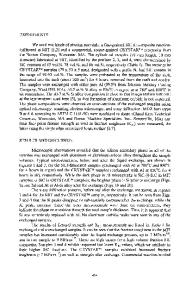Effect of reinforcements and processing method on mechanical properties of glass and basalt epoxy composites
- PDF / 1,344,036 Bytes
- 6 Pages / 595.276 x 790.866 pts Page_size
- 71 Downloads / 392 Views
Effect of reinforcements and processing method on mechanical properties of glass and basalt epoxy composites C. R. Raajeshkrishna1 · P. Chandramohan2 Received: 19 January 2020 / Accepted: 15 April 2020 © Springer Nature Switzerland AG 2020
Abstract The effect of reinforcement material and manufacturing method on tensile, impact, and hardness properties of glass and basalt laminated composites were studied. Woven glass and basalt fabrics were used as reinforcements along with a thermosetting epoxy matrix to fabricate the laminate composites. The glass and basalt epoxy composites were made using hand layup with compression, vacuum bagging, and vacuum-assisted resin infusion methods. The characterization tests are performed as per the ASTM D638-10, ASTM D256, and ASTM D2240 standard respectively. The basalt epoxy composites show improved mechanical properties compared to the glass–epoxy composites. Further, hand layup, along with compression moulding and resin infusion methods, were found to be beneficial in improving the mechanical properties of the composites. Field emission scanning electron microscopic analysis conveyed the adhesion between fibers and resin as well as the voids retained within the matrix are the dominant factors that determined the mechanical properties of the laminated composites such as tensile, impact strength and hardness. Keywords Basalt · Glass · Processing methods · Voids · Mechanical properties
1 Introduction Due to high stiffness to weight ratio and high process ability, the fiber-reinforced polymer composites are used in aerospace, automobile, marine and defense sector [1]. The reinforcement of fibers escalates the properties of the composite materials [2]. Design methodologies also have been proposed to reduce the aircraft weight by using more than 50% of primary structural components by fiber reinforced epoxy composites [3]. The reinforcing phase can be in the form of fibers (short and long), particles, or flakes. The critical length that decides the short/long fiber is 10 mm. The commonly used composites in aircraft industry include polymer matrix composites (PMC) and metal matrix composites (MMC). Few studies also been reported in improving the properties of the polymer composites by
using alternative manufacturing method to achieve high performance composites. According to the form of reinforcing material and matrix, the manufacturing method varies [2, 4]. In the domain of the polymer matrix with fiber reinforcement, there are different manufacturing methods suggested by the diverse research group for aeronautical/ marine applications [1–4]. Kanthraju et al. [1] fabricated glass–basalt hybrid fiber with and without fillers like graphite and Polytetrafluoroethylene (PTFE) using hand layup followed by compression moulding. The experimental investigations on the loading of graphite filler to glass basalt hybrid fiber reinforced composites shows superior mechanical performance compared to unfilled and PTFE filled composites [1]. Mechanical behaviour, microstructure and crack propa
Data Loading...










